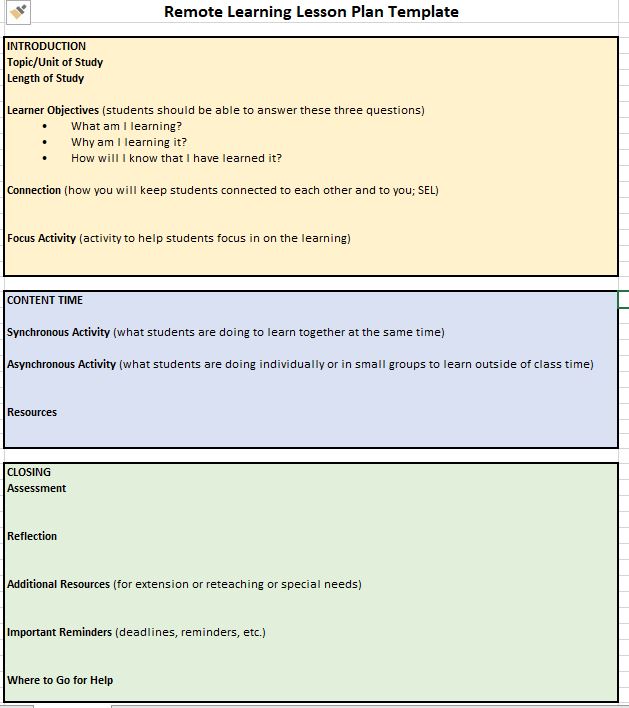If you’ll be teaching remotely to some or all of your students this fall, it’s important to have a clear lesson plan format to follow. Your district has probably provided you with one in the past. But has it been updated to fit remote teaching and learning? Here is a sample lesson plan template designed for when students who will be learning remotely; it should work for any subject or grade level and is based on the latest research. I’ve purposely kept it simple for ease of use. Feel free to add whatever additional content you want or need.

The Format of the Remote Learning Lesson Plan
To make things simple, this lesson plan sample has three broad sections: Introduction, Learning, and Closing. The Introduction section contains information about the following:
- The topic or unit of study
- The length of time to be spent on the topic in this lesson
- Learner objectives
- Connection
- Focus activity
The learner objectives are critical, and what makes them work for long-term learning is that students are able to answer three questions about what they are studying:
- What am I learning?
- Why am I learning it?
- How will I know when I have learned it?
That means that the students must clearly understand the standards being taught and the level to which they must master the standards. This should be stated in language that the students, regardless of age, can understand. Specificity is key. It’s not enough for them to say “I’m learning how to add.” Instead, they must be able to define that they are “learning how to add two digit numbers.”
The connection piece is most important for remote learning. It’s how you are going to help the students (and yourself) continue to bond with each other. This is where you can use some Social Emotional Learning (SEL) activities, ice breakers, getting to know you’s, or other similar strategies. The key is to help students remain connected even though they are distant from each other.
Finally, the focus activity helps to center the students in what they will be learning in this lesson. It could be something as simple as them sharing what they learned the previous day, a short video to gain their interest, an opening activity to raise questions, or a quick KWL about what they already know about the topic. The key here is to get their minds targeted on the learning that is about to take place, to get them focused.
Content Time
While not an elegant name for this section, it’s here that the real work of learning begins. In a remote classroom, there can basically be two types of activities: synchronous and asynchronous. Synchronous activities are those that happen with all of the students in the class at the same time. This could be from you, from online resources, from other students, etc. But the main thing is that all of the students are doing it at the same time. The activities, however, can vary from student to student, depending on how you have decided to differentiate. It’s the timing that makes this unique.
Asynchronous learning occurs next as students go off on their own (or in small groups) to learn. The teacher is not directly involved. This may mean they are working math problems, watching a video, writing a paper, or doing a hands-on activity outside of assigned class time. For successful asynchronous learning, the student must first understand the concepts being taught. It is a complete waste of time to have them practice something they do not understand and may even result in them learning the content the wrong way.
There is also a place in this section of the lesson plan template to list the resources students or the teacher will be using to master the content. This is for both synchronous and asynchronous learning.
Closing Out the Remote Learning Lesson Plan
The final section of the lesson plan is where we see how successful the students have been in their learning. There is assessment followed by student reflection on their own processes and results of learning. Additional resources are provided by the teacher for those who want to extend their mastery or need additional support.
Lastly, there is a place in the lesson plan for reminders to the students (deadlines, upcoming quizzes or tests, important announcements, etc.). It is also important, especially in remote learning, to provide information on where the students can go to get additional help. This could be virtual “office hours” or a tutor or extra videos or resources that explain the content differently than it has already been presented. I’ve even seen a teacher post a “panic button” in her Google Classroom that students can click on when they are struggling; the button creates an instant email to the teacher for help. All of this is designed to remind students that, although they are working remotely, they are not alone.
This remote lesson plan is very simple, but I hope it can act as a starting point for you in thinking about how to craft your teaching differently for remote learning. If you would like additional help in creating the best remote learning experiences for your students, check out the online, self-paced Remote Learning Educator Certification course. Priced at just $49 (less when 10 or more registrations are purchased), the course features six modules that include best practices, video how-to’s, and tips and tricks for communication, designing remote lessons, social and emotional learning, teaching platforms, and safety and security. You can also find more than 50 videos on remote learning available here.


1 comment
This is all very new to me, but am very much anxious to use the tools and advice for using this program.